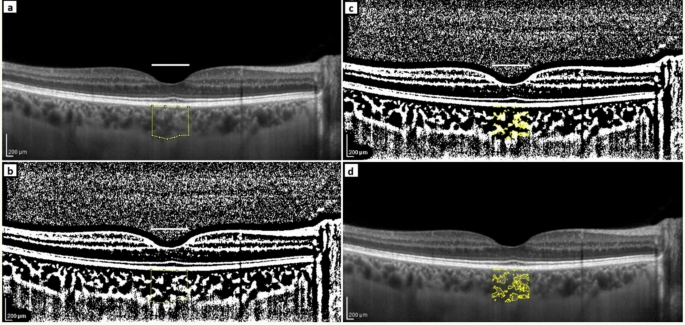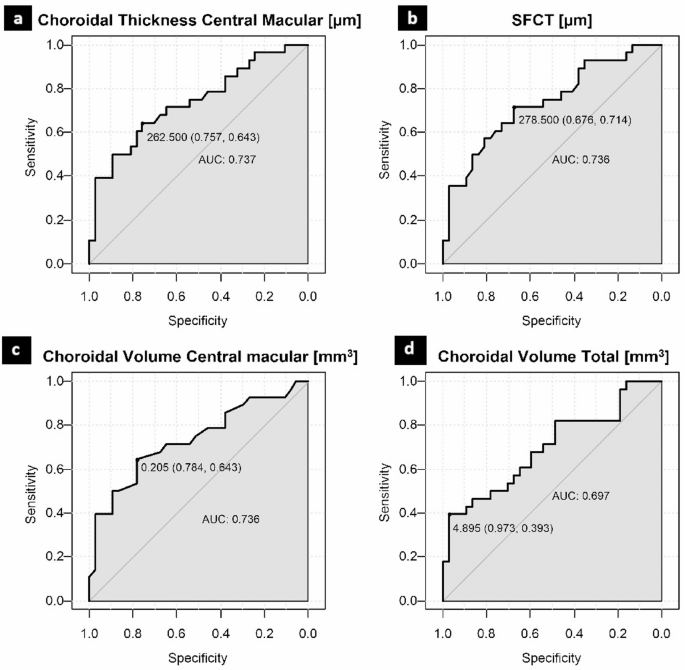This prospective, single-center, cross-sectional study was conducted between 2021 and 2023 at the Ophthalmology Department of the Medical University of Bialystok. The study involved 29 adult PPH patients admitted for routine clinical assessment to the Department of Cardiology and Internal Diseases of the Medical University of Bialystok, that were on stable PPH pharmacotherapy.
The control group was composed of 37 healthy adult patients (self-reported) undergoing routine ophthalmological assessments. One randomly selected eye per patient was included in the analyses.
The protocol of the study was approved by the local Bioethics Committee at the Medical University of Bialystok (decision no APK.002.290.2020), and the study was conducted in accordance with the Declaration of Helsinki. The informed written consent was obtained from each patient in both groups.
The diagnostic ophthalmologic workup for all participants included refraction, best corrected visual acuity (BCVA) in Snellen converted to logMAR, intraocular pressure (IOP) measured with a Pascal dynamic contour tonometer (DCT; Zeimer Ophthalmic Systems AG, Port, Switzerland), slit-lamp biomicroscopy, keratometry and AL measured with a Tomey OA-2000 biometer (Nagoya, Japan), spherical equivalent with Topcon KR-8900 auto kerato-refractometer (Tokyo, Japan), dilated fundus examination, and enhanced depth imaging optical coherence tomography (EDI-OCT; Heidelberg Engineering GmbH, Heidelberg, Germany; 2016). Blood pressure was measured in the sitting position after 5 min of rest, and OCT images were obtained immediately afterwards for all the patients. Data regarding age, sex, current smoking status, PPH duration, and details of systemic treatment were recorded. The PPH patients were diagnosed according to the European Society of Cardiology guidelines with right heart catheterization, that confirmed precapillary pulmonary hypertension (estimated mean pulmonary artery pressure [eMPAP] ≥ 25 mmHg and pulmonary artery wedge pressure [PAWP] ≤ 15 mmHg) with elevated pulmonary vascular resistance (PVR) (> 3 Wood units [WU])1. PPH group included patients with idiopathic pulmonary arterial hypertension as well as related to congenital heart defects or associated to connective tissue diseases, and patients with chronic thromboembolic pulmonary hypertension. Patients with significant lung disease or PH secondary to left heart diseases were not included in the study. The following parameters characterizing PPH were obtained: disease history, physical examination, echocardiography, right heart catheterization, laboratory and functional tests: WHO functional class, presence of peripheral edema, N-terminal pro B-type Natriuretic Peptide concentration and results of 6-minute walk tests. In order to ensure proper classification, echocardiographic parameters like tricuspid annular plane systolic excursion (TAPSE), right ventricular systolic function, tricuspid regurgitation peak gradient, estimated mean pulmonary arterial pressure (eMPAP), estimated pulmonary artery systolic pressure, right atrial pressure (RAP), right atrial area (RAA), right ventricular diameter in four-chamber (4CH) view were included. PPH treatment strategies were carefully analyzed36. Exclusion criteria applicable to both groups encompassed ophthalmological factors: the presence of fundus pathology, ametropia ≥ 3 diopters, cataract surgery shorter than 12 months prior to examination, history of posterior segment surgery, retinal laser treatment, and poor quality of OCT scans (< 25 dB).
OCT imaging and analysis
The OCT imaging protocol for macula (Fig. 2) was composed of 25 raster scans (20°× 20°) and a linear 30° B-scan centered at the fovea. Choroidal thickness and volume were determined in the same manner as described in detail in our previous studies34,37. Briefly, the internal limiting membrane (ILM) and Bruch’s membrane (BM) were detected automatically, while the choroidal–scleral junction (CSJ) was manually marked on each scan. Retinal parameters were calculated from the ILM to the BM, and choroidal parameters – from the BM to the CSJ. Average thickness and volume maps were created automatically according to the conventional ETDRS grid with nine subfields including the central macular subfield (central field within a 500 µm radius)38. Values of the choroidal parameters were calculated by subtracting retinal parameters from the summed retinal and choroidal parameters. The subfoveal choroidal thickness (SFCT) was defined as the distance between the BM and the CSJ at the fovea and was measured automatically. In our study, we used the term ‘subfoveal’ to specifically refer to the central point directly beneath the fovea (i.e., a single-point measurement), whereas ‘central macular’ referred to the 500 μm radius region centered on the fovea.
Analyzed choroidal and retinal regions superimposed on the fundus image.
CVI assessment was performed according to the protocols of Sonoda et al.39 and Agrawal et al.13, with minor modifications as detailed in a step-by-step description with screenshots in our previous publication34. Binarization of the macular choroidal area was performed by two researchers (AZ and BP) (Fig. 3). The macular region was scanned using a single horizontal line scan (30°) centered on the fovea, with 100 frames averaged in a B-scan. The measurement area was defined as 1000 μm in width and centered on the fovea. The total choroidal area (TCA) was selected from the outer boundary of the RPE–BM layer to the CSJ using the polygon selection tool. The images were converted into 8-bit images to allow for the application of the Niblack auto local threshold tool. The binarized images were reconverted into RGB images to allow for the color threshold tool to be used for selecting dark pixels that represented vascularized areas. The luminal area (LA) and TCA were measured, while the stromal area (SA) was calculated by subtracting the LA from the TCA. The CVI was determined as the ratio of the LA to the TCA (%). The parameters were assessed by two experienced researchers (AZ and BP) at the same time of the day (8–10 am) in both groups, with the averages from 2 measurements included in the analysis. Any doubts were resolved through discussion. The repeatability of measurements between observers was determined using the intraclass correlation coefficient (ICC) and overall agreement. The ICC was high, as shown in Table 7.

Image binarization of the choroid. a Total choroidal area marked on the analyzed enhanced depth imaging optical coherence tomography (EDI-OCT) scan. The horizontal white line length equals 1000 μm. b The Niblack auto local threshold tool applied. c The color threshold tool applied highlighting the luminal area. d Overlay of luminal area on the original OCT scan.
According to the related literature40, the ICC values below 0.5 are indicative of poor reliability, the values between 0.5 and 0.75 indicate moderate reliability, the values between 0.75 and 0.9 indicate good reliability, and the values greater than 0.90 indicate excellent reliability.
With respect to ocular magnification correction, axial and transverse measurements must be handled separately. Axial depth on the Heidelberg Spectralis is optically calibrated for tissue refractive indices (e.g., choroidal thickness), so axial scaling is independent of ocular magnification and requires no further correction41. In contrast, the Spectralis does not auto-correct lateral scaling for individual axial lengths42. However, because our PPH and control groups did not differ in axial length, corneal curvature, or spherical equivalent (Table 1; all p > 0.05), any residual magnification error is likely to be minimal and unlikely to bias between-group comparisons. Moreover, our primary lateral metric, the CVI, is the ratio of LA to TCA 13, so a uniform scaling factor applies equally to numerator and denominator and thus has no effect on the CVI. Together, these factors render magnification error minimal and non-differential; therefore, we omitted individual ocular magnification corrections.
Post-hoc power calculation
The relatively small number of patients is due to the rarity of PPH and the sample size was partly determined by the number of participants who had met our inclusion criteria.
The post-hoc power calculation, assuming α = 0.05 and using the means and SDs obtained in the study for the comparison of PPH and controls patients, resulted in a power (1-β) of 0.96 for central macular choroidal thickness, volume, and SFCT, and 0.90 for total choroidal volume. The power calculation for the CVI equaled 0.16.
Statistical analysis
Data included one eye per patient, randomly selected (left/right) by an independent statistician, to avoid potential bias from selection of only right or only left eyes43. The choroidal assessments by two investigators were averaged. Data are presented as n (% of group) for nominal variables or as mean ± SD or median (Q1; Q3) for continuous variables, as appropriate. Normality of distribution was assessed by means of using Shapiro-Wilk test as well as skewness and curtosis values. The comparison of the groups was based on tests: Fisher exact test or chi-square test for nominal data, Welch t-test or Mann-Whitney U test for continuous data, as appropriate. Additionally, MD (mean difference) between both groups was calculated, including 95% confidence interval (CI). Predictive performance of the choroidal thickness for PPH vs. controls was compared using the area under the receiver operating characteristic curve (AUC). Sensitivity and specificity values were reported at the cutoff points determined by the Youden index. The univariable linear regression analysis was carried out to determine the relationship between choroidal and cardiological parameters. Additionally, a multivariable regression analysis was performed for the selected parameters, with group (PPH vs. control) as the independent variable and the following confounders: systolic blood pressure, diastolic blood pressure, MAP, and caffeine intake. Benjamini–Hochberg correction for multiple comparisons was applied to control the false discovery rate at 5%, and both unadjusted and BH-adjusted p-values were reported. Benjamini–Hochberg adjustment was performed using the p.adjust function in R. For each linear regression model, the coefficient of determination (R2) and adjusted coefficient of determination (adjusted R2) were calculated and reported as measures of model fit.
The statistical analysis was conducted by means of R 4.2.1. statistical software (R Core Team (2022). R: Language and environment for statistical computing by R Foundation for Statistical Computing, Vienna, Austria). The post hoc power calculation was carried out by means of G*Power 3.1.9.7. software. All calculations were based on α = 0.05.
